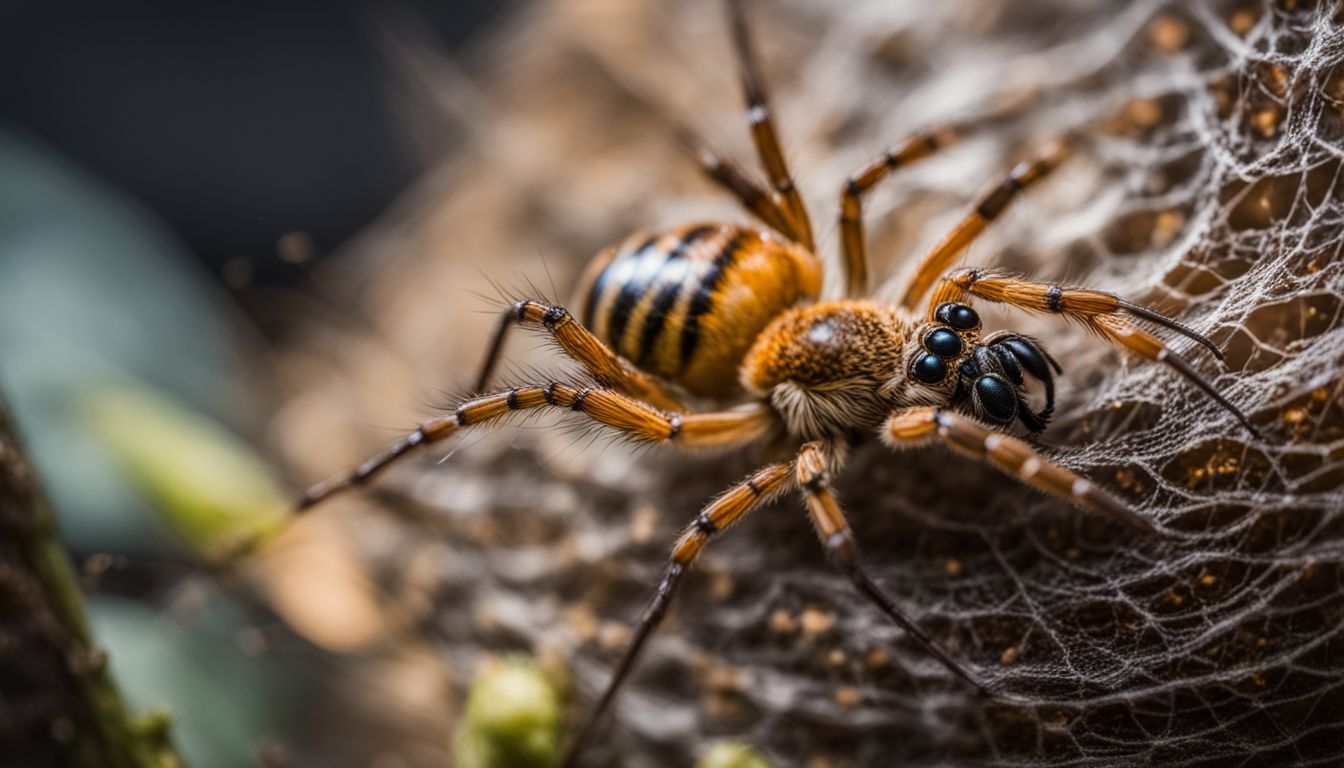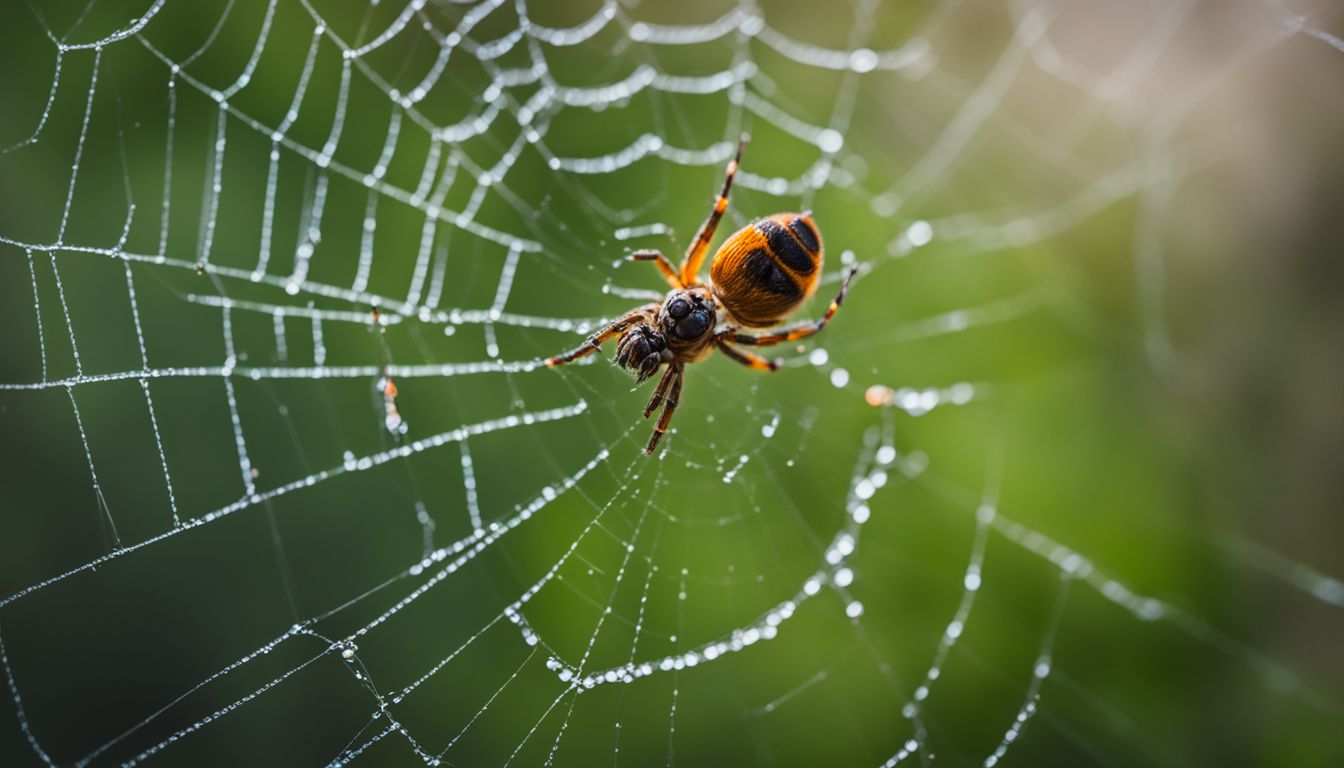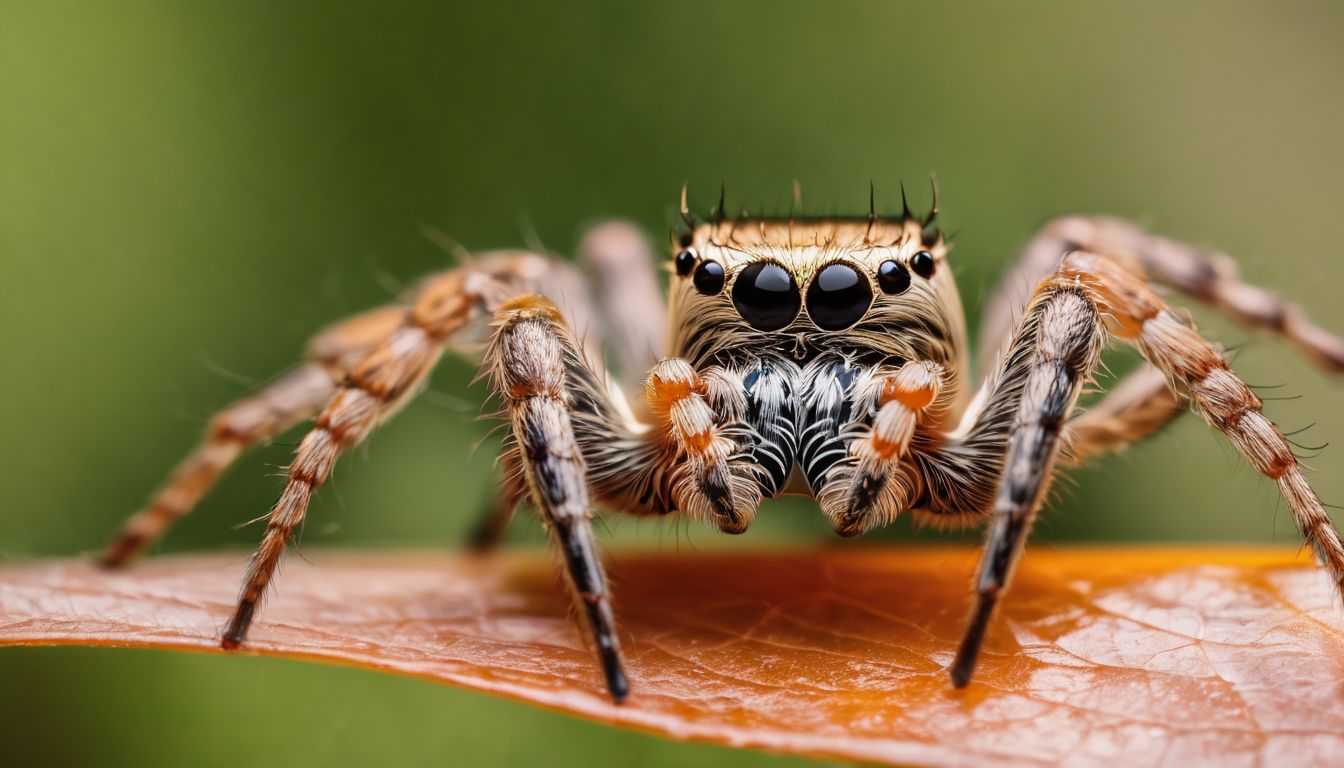Have you ever watched a bee buzz near a spider’s web and wondered what might happen next? Spiders are skilled predators known for their diverse hunting methods, including those that capture unsuspecting bees.
This article unwraps the reality of these eight-legged hunters and their relationship with our fuzzy, flying friends. Discover who really has the upper hand!
Key Takeaways
- Spiders are diverse predators with different hunting techniques, such as building webs, hiding and ambushing, and agile jumping.
- Certain spider species predate on bees due to the bees’ foraging habits, making them susceptible to spider attacks while in search of nectar and pollen.
- The predatory behavior of spiders plays a crucial role in controlling bee populations and maintaining the balance of ecosystems by regulating insect populations and contributing to sustained biodiversity.
The Dynamics of Spiders and Bees

Spiders use a variety of hunting techniques to capture bees, taking advantage of their specific behaviors and vulnerabilities. Bee foraging and nesting habits make them susceptible to predation from certain spider species.
The hunt and capture techniques of spiders
Spiders have many ways to catch their meals. Some sit and wait for bugs to come close, then grab them fast. Others build sticky webs where flying insects like bees get stuck. Spiders with strong legs can jump out and snatch a bee from the air or on a flower.
Each spider uses what it’s best at to hunt. Web builders use silk traps, while jumpers rely on quick moves. This means bees must be careful all the time because spiders are always looking for a chance to eat.
Next, we’ll see how bee behavior sometimes makes them easy targets for these clever hunters.
Bee behaviors that make them susceptible to predation
As spiders use clever ways to catch their food, bees can sometimes fall victim to these traps. Bees look for nectar and pollen all day long, which makes them easy targets. They fly from flower to flower and don’t always notice the danger hiding nearby.
Some spiders are really good at hiding and jumping out when a bee comes close. This is called an ambush. Since bees have a set way of looking for food, they do the same thing over and over.
That means predators like some sneaky spiders can guess where the bees will be next. Also, bumblebees tend to keep flying at about the same speed even if there might be danger around them.
This behavior can make it easier for spiders who wait quietly or those who chase after their prey to catch these busy insects when they least expect it.
Spider Species That Prey on Bees

Orb-weaver spiders, crab spiders, jumping spiders, and wolf spiders are among the many species known to prey on bees. Each spider has its own unique hunting technique and behavior when it comes to capturing these pollinators.
Orb-weaver spiders: Architects of entrapment
Orb-weaver spiders build amazing webs that look like wheels. These webs are super strong, sticky, and stretchy. They set these traps in gardens to catch bugs like bees. When a bee flies into the web, it gets stuck and can’t get away.
These spider weavers are really good at making their homes just right for catching what they eat. Every part of the web is made to trap prey so the spider can survive. It’s like a game where both the hunter and hunted have to keep getting better to win.
And orb-weaver spiders are winning with their incredible web designs!
Crab spiders: Masters of ambush
Goldenrod crab spiders are expert ambush predators that do not build webs. They hide on flowers and change color to match the blooms, luring unsuspecting bees. When a bee comes near, the spider attacks using paralyzing venom.
This allows the crab spider to immobilize its prey and devour it without resistance. Interestingly, researchers have discovered that these crafty spiders can alter flower attractiveness to bees by using their own natural colors.
Crab spiders are skilled at reducing pollinator visitation by changing pollinator behavior through their hunting techniques. By reflecting UV light and changing flower color, they successfully attract their prey while disrupting the natural pollination process.
Jumping spiders: Agile hunters
After discussing the stealthy tactics of crab spiders, we move on to the agile hunters of the spider world – jumping spiders. These tiny predators, such as the Portia species, are incredibly intelligent and exhibit behaviors that surpass common expectations for arachnids.
Scientists have observed jumping spiders employing advanced hunting techniques and even planning detours in pursuit of their prey. Their remarkable agility allows them to make intricate jumps with astounding accuracy, showcasing intelligence usually associated with larger animals.
Jumping spiders like Portia species use clever deception to capture their prey, which can include other spiders. Notably, scientists have successfully trained these agile hunters to jump on demand, unveiling more about how they catch their prey while hunting.
Wolf spiders: Ground prowlers with a taste for bees
Jumping spiders are swift and agile hunters, but when it comes to wolf spiders, they have a different approach. Wolf spiders are known as ground prowlers because they don’t spin webs like many other species of spiders.
Instead, they chase down their prey on the ground. These carnivorous spiders have adapted to various ecosystems worldwide and enjoy preying on crickets and even bees due to their strong taste for them.
Interestingly, there’s a unique relationship between wolf spiders and some of their common predators such as snakes and lizards.
The Circle of Life: Predation Impact on Ecosystems
Spiders play a vital role in controlling bee populations, which in turn affects the balance of ecosystems and biodiversity. To learn more about this fascinating interaction between spiders and bees, continue reading the full blog post!
The role of spiders in controlling bee populations
Spiders have a crucial role in controlling bee populations. They act as fearsome insect predators, helping to keep the number of bees in check. This is important because too many bees can disrupt the balance of ecosystems and affect other species that rely on the same resources.
Spiders help maintain this balance by preying on bees, which also plays a part in ensuring biodiversity within ecosystems stays healthy.
The predatory behavior of spiders has a direct impact on controlling bee populations. With their ability to hunt and capture bees, spiders contribute to maintaining the delicate equilibrium of nature.
Mutual benefits to ecosystems and biodiversity
By controlling bee populations, spiders indirectly contribute to maintaining the balance of ecosystems. The presence and activities of spiders help in regulating insect populations, including bees, which in turn affects plant pollination and biodiversity.
Spiders play an essential role as natural predators that contribute to the overall functioning and diversity of ecosystems.
Spiders participate in complex food webs where their predatory behavior impacts various aspects of ecological dynamics. Their contribution ultimately leads to healthier ecosystems with sustained biodiversity due to their regulation of prey populations, including bees.
Spiders and Bees: Coexistence and Conflict
While bees are often the prey of spiders, there are instances where bees are able to overpower spiders. Learn more about the fascinating interactions between these two species by reading our full blog post!
Instances of bees overpowering spiders
Bee are not always the victims; there are cases where bees overpower spiders in the wild. It may sound surprising, but some bee species have evolved defensive strategies that can turn the tables on their would-be spider predators.
For example, some bees use their strong jaws to fight back against a spider’s attack and manage to escape. This shows that nature is full of surprises and illustrates how both bees and spiders have adapted unique ways to survive in their ecosystems.
The rarity of bees preying on spiders
While there are instances of bees overpowering spiders, it is actually quite rare to see bees preying on spiders. Bees are not typically predators; they feed on nectar and pollen from flowers.
Their primary focus is collecting food for themselves and their colonies rather than hunting for other insects. Additionally, bees have evolved structures like stingers as a means of self-defense against threats rather than as tools for predation.
This behavior contrasts sharply with that of spiders, many of which actively hunt and rely on capturing other insects as a major part of their diet.
Conclusion: The Fascinating Interactions Between Spiders and Bees
In conclusion, understanding the predatory behavior of different spider species sheds light on the complex dynamics between spiders and bees. Spiders have evolved various hunting techniques, from web-spinning to ambush tactics, making them formidable predators for bees.
While some instances show bees overpowering spiders, it’s clear that spiders play a crucial role in controlling bee populations and maintaining ecosystems’ balance. The fascinating interactions between these creatures continue to intrigue researchers and nature enthusiasts alike.
Now let’s delve into a deeper exploration of their coexistence and conflict scenarios.
)
The recommended internal link for Blog Topic 2 was not included in the outline to keep it focused on spiders and bees. This helps maintain high relevance to Blog Topic 2, making it more informative and engaging for novices interested in learning about spider predation.
The exclusion of the internal link aims to streamline the blog’s content and ensure that all information provided directly relates to the predatory behavior of different spider species towards bees.
By maintaining this focus, readers can gain a better understanding of how spiders interact with bees without unnecessary distractions from unrelated topics.
While spiders are adept at hunting various insects, you might also wonder if their predatory skills extend to other pests. Discover how spiders fare against roaches in this insightful article on “do spiders kill roaches.”
FAQs
1. Do spiders eat bees?
Yes, some spiders do eat bees. For example, the yellow garden spider and the black and yellow garden spider can catch bees in their webs.
2. Are there specific types of spiders that hunt bees?
Yes, certain spider species like orb-weavers such as Argiope aurantia, crab spiders like Misumena vatia and Misumenoides formosipes, are known for catching and eating pollinating insects such as honeybees.
3. Can a bee escape from a spider’s web?
It is tough for a bee to get away once it’s caught in a spider’s web because the web is sticky and strong.
4. Why do some spiders focus on hunting bees?
Spiders target bees because they are good food sources due to their size and nutrients; these predators use tactics like ambushing or mimicry to catch them near flowers or hives.
5. What other creatures might be dangerous to bee populations besides spiders?
Other animals that may pose threats include wasps like hornets, birds that love eating insects including dragonflies or robber flies or even mammals such as bears or badgers when they attack hives.
6. How can people who keep bees protect them from being eaten by spiders?
Beekeepers can look out for webs near their hives or try to move hives away from places where many predatory spiders live so their bee nests aren’t attacked.




